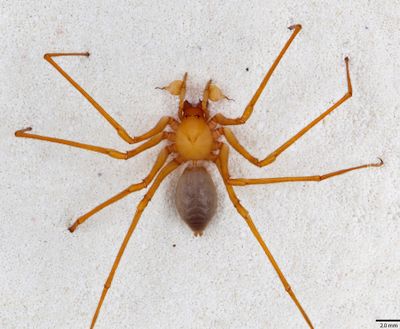New spider family found in Oregon
Distinct taxonomic family lives in cave

GRANTS PASS, Ore. – Amateur cave explorers have found a new family of spiders in the Siskiyou Mountains of Southern Oregon, and scientists have dubbed it Trogloraptor – Latin for cave robber – for their fearsome front claws.
The spelunkers sent specimens to the California Academy of Sciences in San Francisco, which has the West Coast’s largest collection of spiders. Entomologists there say the spider – reddish brown and the size of a half dollar – evolved so distinctly that it requires its own taxonomic family – the first new spider family found in North America since the 1870s.
“It took us a long time to figure out what it wasn’t,” said Charles Griswold, curator of arachnids at the academy. “Even longer to figure out what it is. We used anatomy. We used DNA to understand its evolutionary place. Then we consulted other experts all over the world about what this was. They all concurred with our opinion that this was something completely new to science.”
The discovery is described in the Friday online edition of the journal ZooKeys.
Norman I. Platnick, curator emeritus of spiders at the American Museum of Natural History, said the discovery was as exciting to spider scientists as the discovery of a new dinosaur to paleontologists.
“Because it belongs to one of the more primitive groups of true spiders, it has the potential to change many of our current ideas about the early evolution of spiders,” he said. “But it is better than a fossil, because we can study the entire organism, along with its behavior and physiology, not just those aspects that happen to have been fossilized.”
Jonathan Coddington, curator of arachnids at the Smithsonian Institution, said caves tend to keep primitive species from evolving, because they are sheltered from climatic and other changes.
“Once you figure out a lifestyle, you can just do it for millions of years,” he said.
The Oregon spider’s species name – marchingtoni – honors Deschutes County sheriff’s Deputy Neil Marchington, who was on the first Western Cave Conservancy expedition in 2010 to inventory the critters in a cave on private land outside Grants Pass. A year later he led academy scientists to the site to collect live specimens.
“We don’t know exactly how they work yet,” Griswold said of the spiders. “We’ve seen these spiders alive. But we haven’t seen them eat anything yet. They are very shy.
“They make a little web, but hang under this web. They hang some of their legs out in space. This is all in the dark in a cave. We think the legs are stretched out waiting for something to come by, like a fly, and when it hits the legs, the claws may just snap shut.”
Though scientists built a small artificial cave for the spiders in their lab, the spiders would not eat any of the insects, and died.
After the spiders were found in the Oregon cave, scientists from San Diego State University went looking in the redwoods of Northern California, and found a spider in the same family, but a new species, living in underground cavities beneath boulders and logs, Griswold said.